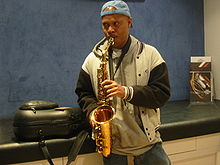

This biography of a living person needs additional citations for verification. Please help by adding reliable sources. Contentious material about living persons that is unsourced or poorly sourced must be removed immediately from the article and its talk page, especially if potentially libelous.
Find sources: "Steve Coleman" – news · newspapers · books · scholar · JSTOR (October 2018) (Learn how and when to remove this message) |
Steve Coleman
| |
|---|---|

Steve Coleman in Paris, July 2004
| |
| Background information | |
| Birth name | Steven Douglas Coleman |
| Born | (1956-09-20) September 20, 1956 (age 67) Chicago, Illinois, U.S. |
| Genres | Jazz, avant-garde, M-Base |
| Occupation(s) | Musician, composer, bandleader |
| Instrument(s) | Saxophone |
| Labels | JMT, Pangaea, Novus, BMG, Label Bleu, Pi |
Steve Coleman (born September 20, 1956)[1] is an American saxophonist, composer, bandleader and music theorist. In 2014, he was named a MacArthur Fellow.
Steve Coleman was born and grew up in South Side, Chicago.[1] He started playing alto saxophone at the age of 14. Coleman attended Illinois Wesleyan University for two years,[1] followed by a transfer to Roosevelt University (Chicago Musical College).
Coleman moved to New York in 1978 and worked in big bands such as the Thad Jones/Mel Lewis Orchestra, Slide Hampton's big band, Sam Rivers' Studio Rivbea Orchestra, and briefly in Cecil Taylor's big band.[2] Shortly thereafter, Coleman began working as a sideman with David Murray, Doug Hammond, Dave Holland, Michael Brecker and Abbey Lincoln. During his first four years in New York, Coleman played in the streets and in small clubs with a band that he put together with trumpeter Graham Haynes. This group would evolve into Steve Coleman and Five Elements, which would serve as the main ensemble for Coleman's activities. In this group, he developed his concept of improvisation within nested looping structures. Coleman collaborated with other young African-American musicians such as Cassandra Wilson and Greg Osby, and they founded the so-called M-Base movement.[1]
Coleman regards the music tradition he is coming from as African Diasporan culture with essential African retentions, especially a certain kind of sensibility. He searched for these roots and their connections of contemporary African-American music. For that purpose, he travelled to Ghana at the end of 1993 and came in contact with (among others) the Dagomba (Dagbon) people whose traditional drum music uses very complex polyrhythm and a drum language that allows sophisticated speaking through music (described and recorded by John Miller Chernoff[3]). Thus, Coleman was animated to think about the role of music and the transmission of information in non-western cultures. He wanted to collaborate with musicians who were involved in traditions which come out of West Africa. One of his main interests was the Yoruba tradition (predominantly out of western Nigeria) which is one of the Ancient African Religions underlying Santería (Cuba and Puerto Rico), Vodou (Haiti) and Candomblé (Bahia, Brazil). In Cuba, Coleman found the group Afrocuba de Matanzas who specialized in preserving various styles of rumba as well as all in Cuba persisting African traditions which are mixed together under the general title of Santería (Abakuá, Arara, Congo, Yoruba). In 1996 Coleman along with a group of 10 musicians as well as dancers and the group Afrocuba de Matanzas worked together for 12 days, performed at the Havana Jazz Festival, and recorded the album The Sign and the Seal. In 1997 Coleman took a group of musicians from America and Cuba to Senegal to collaborate and participate in musical and cultural exchanges with the musicians of the local Senegalese group Sing Sing Rhythm. He also led his group Five Elements to the south of India in 1998 to participate in a cultural exchange with different musicians in the carnatic music tradition.
In September 2014, Coleman was awarded a MacArthur Fellowship for "refreshing traditional templates to create distinctive and innovative work in ... jazz."[4][5]
In 2017, Steve Coleman was accused by saxophonist Maria Grand of sexual harassment, accusing him of taking advantage of his position as a mentor to coerce a sexual relationship from 2011 to 2016. Coleman replied by October 2018 with a lawsuit and a $500,000 compensation claim for lost musical engagements as a result of these revelations. [6] In March 2021, the judgment ruled in favor of Maria Grand. [7]
|
With Doug Hammond
With Dave Holland
With Thad Jones/Mel Lewis
With Mel Lewis
With Abbey Lincoln
With Errol Parker
With The Roots
With Cassandra Wilson
|
With others
|
|
| |
|---|---|
| Albums |
|
| Related articles |
|
| International |
|
|---|---|
| National |
|
| Academics |
|
| Artists |
|
| Other |
|